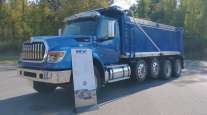Navistar’s 4Q Profit Dips on Engine Costs
This story appears in the Jan. 3 print edition of Transport Topics.
Truck and engine maker Navistar International Corp. said its fiscal fourth-quarter profit fell to $39 million from $86 million last year, as costs related to engine development and a new labor contract with United Auto Workers chipped away at results.
Navistar, which builds International trucks and MaxxForce engines, said revenue was $3.37 billion for the quarter, up from $3.29 billion a year ago.
For the full year ended Oct. 31, net income was $223 million, down from $320 million in 2009. Revenue rose to $12.1 billion from $11.6 billion.
“The North American truck market has been depressed for three years now, and the company has been able to provide good profits while investing in the future growth,” Daniel Ustian, Navistar’s chairman and CEO, said in a company statement.
Navistar said its truck division earned $86 million in the fourth quarter, up from $5 million a year ago. For all of fiscal 2010, trucks earned $424 million, up from $147 million.
“The increase was aided by improvements in commercial markets, in spite of 50-year industry lows, as well as materials and cost reduction from the company’s manufacturing strategy,” Navistar said.
Navistar’s engine segment, however, lost $17 million in the fourth quarter, compared with a profit of $123 million a year earlier.
For the full year, the engine segment reported a profit of $51 million, down from $253 million. Navistar said money received in a settlement with Ford Motor Co. for ending their medium-duty engine partnership contributed to the strong results during 2009.
The parts division had a profit of $77 million in its fourth quarter, down from $124 million last year. Navistar’s parts segment earned a profit of $126 million for fiscal year 2010, down from $486 million.
Navistar said that a decrease in military orders accounted for much of the drop in parts sales.
The company said it had met its projection to deliver more than 17,000 vehicles with 2010-compliant engines during the fourth quarter.
Ustian also said the company’s policy of convincing its 15-liter engine customers to switch to the 13-liter model was succeeding faster than expected. Navistar expected 80% of traditional 15-liter customers to switch over to a 13-liter model over 12 to 18 months, he said.
The process “is moving faster than that, and we are about at that level already, going into 2011, so the 13-liter has been a success,” Ustian said.
Navistar didn’t begin wide-scale delivery of its 11-liter and 13-liter engines that meet 2010 standards until well into the summer. It is also developing its first 15-liter engine but postponed production from October of last year until sometime in the first half of 2011.
Ustian said 13-liter engine production had begun at 40 to 50 per day in mid-2010 and has reached 110 per day, and he expects production to reach 200 a day in 2011.
Meanwhile, Navistar noted that provisions in a new contract with the United Auto Workers, as well as preparing for a possible strike, cost $10 million in the fourth quarter.
UAW members employed by Navistar ratified a four-year contract in November covering 2,000 employees in Illinois, Indiana, Ohio, Pennsylvania, Georgia and Texas.
Navistar said another reason for lower fourth-quarter profits was decreased medium-duty engine volumes in North America, associated with the expiration of the company’s contract with Ford.
Navistar added that it expects total truck industry retail sales volume for Classes 6-8 trucks and school buses in the United States and Canada for the year ending Oct. 31, 2011, to be 230,000 to 250,000 units. It estimated the industry made 175,000 to 215,000 unit sales in 2009.




